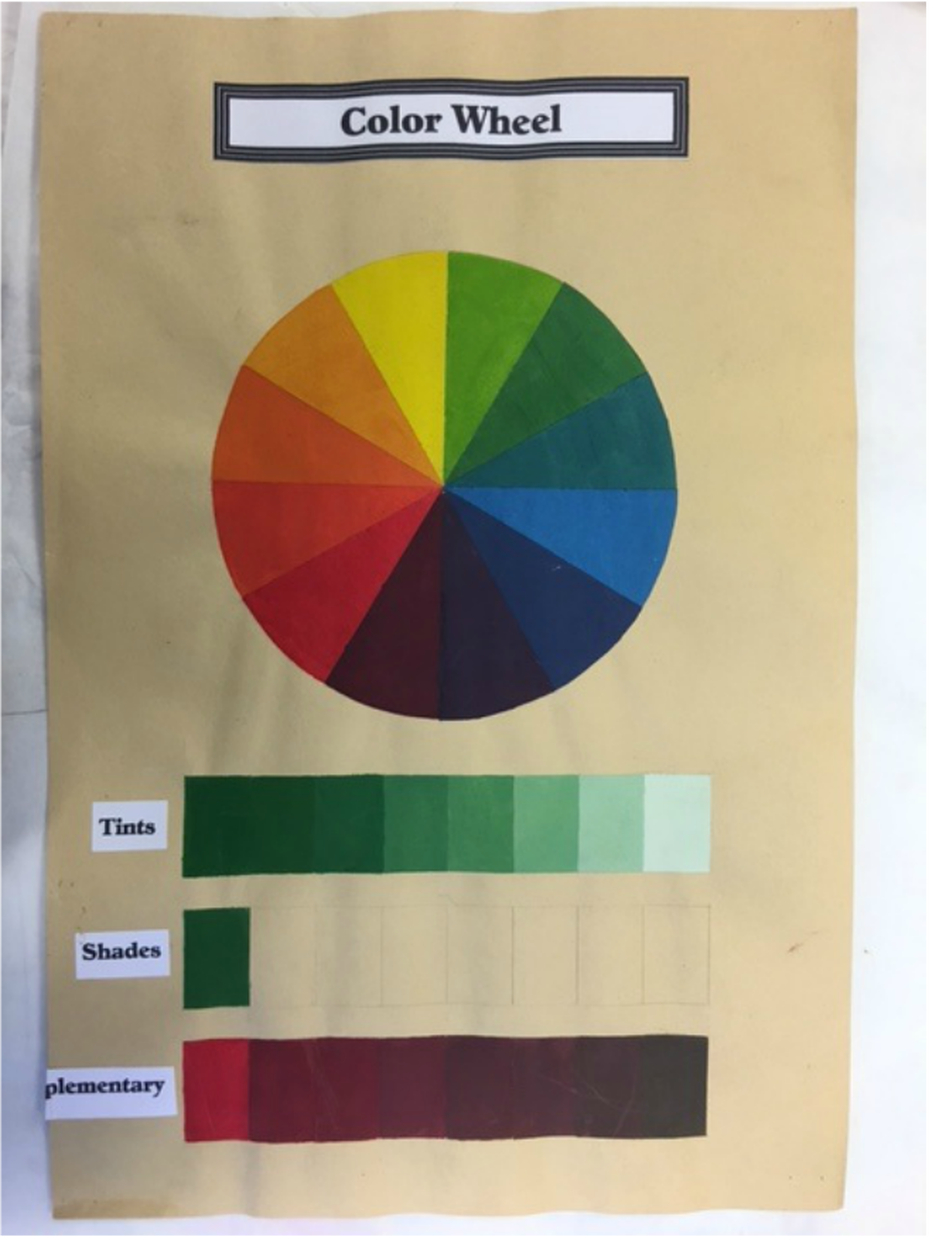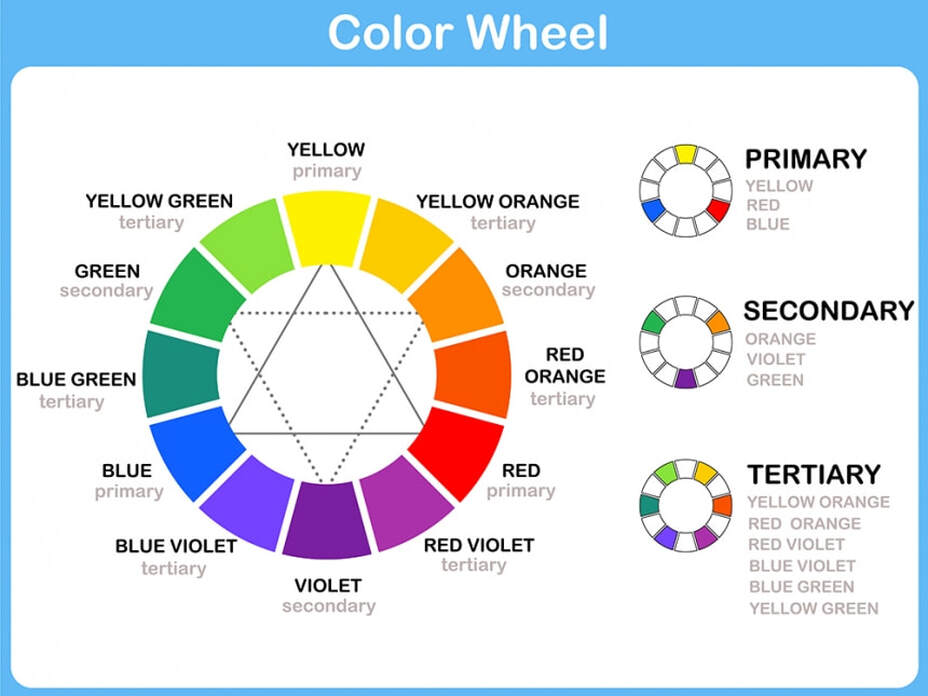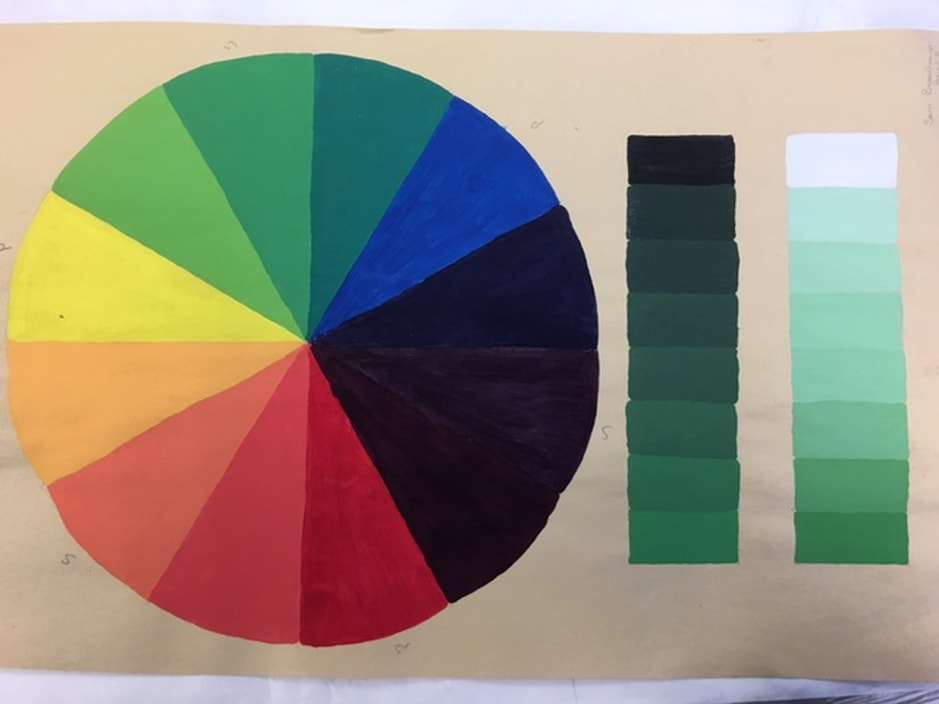Color Wheel & Gradient Study
COLOR WHEEL
A color wheel is a visual representation of colors arranged according to their chromatic relationship. Begin a color wheel by positioning primary hues equidistant from one another, then create a bridge between primaries using secondary and tertiary colors.
COLOR TERMINOLOGY
Primary Colors: Colors at their basic essence; those colors that cannot be created by mixing others.
Secondary Colors: Those colors achieved by a mixture of two primaries.
Tertiary Colors: Those colors achieved by a mixture of primary and secondary hues.
Complementary Colors: Those colors located opposite each other on a color wheel.
Analogous Colors: Those colors located close together on a color wheel.
A color wheel is a visual representation of colors arranged according to their chromatic relationship. Begin a color wheel by positioning primary hues equidistant from one another, then create a bridge between primaries using secondary and tertiary colors.
COLOR TERMINOLOGY
Primary Colors: Colors at their basic essence; those colors that cannot be created by mixing others.
Secondary Colors: Those colors achieved by a mixture of two primaries.
Tertiary Colors: Those colors achieved by a mixture of primary and secondary hues.
Complementary Colors: Those colors located opposite each other on a color wheel.
Analogous Colors: Those colors located close together on a color wheel.

Properties of Color
Primary Colors are naturally occurring. You can not mix other colors to make RED, YELLOW or BLUE.
Secondary Colors are created by mixing 2 primary colors: Red + yellow = orange Yellow + blue = green Blue + red = violet (also called purple)
Intermediate Colors are created by mixing a primary and a secondary color: Red + orange = red orange Orange + yellow = yellow orange Yellow + green = yellow green Green + blue = blue green Blue + violet = blue violet Violet + red = red violet
Shades are created by adding black to a primary, secondary or intermediate color. Shades can add mystery, sadness or coolness to a painting.
Tints are created by adding white to a color. Tints are light and bright and suggest warmth and brightness and happiness.
Intensity can be lowered by adding a color’s complement. To make red less bright or darker, add it’s opposite on the color wheel, which is green.
Color Schemes
Warm Colors are red, yellow, orange, red-orange, yellow-orange. Warm colors feel safe and comfortable, and happy. The sun, pumpkins, a fireplace are warm, comfortable things
Cool Colors are blue, green and purple, blue green, yellow green, blue violet. Cool colors suggest things that are cool, mysterious, even sad. They can also be very calming. Rain, the ocean, ice and the forest are cool feeling.
Complementary color scheme uses one color and its complement, plus tints and shades of those 2 colors. The compliment of yellow is purple. You can mix black or white with both colors.
Split compliment uses a primary or secondary color, and the intermediate color on each side of it’s compliment. For example, a split complement of red would also use yellow-green and blue-green, the intermediate colors on each side of green.
Monochromatic color scheme is one color only, plus tints and shades of that color. For example red would use different pinks and dark reds created by mixing the red with either white or black.
Analagous colors are next to each other on the wheel and share a common primary color. For example: violet, red-violet, red, red-orange, and orange all have the PRIMARY COLOR RED in common, so they are analogous.
Blue-violet, blue, blue-green, and green all have the PRIMARY COLOR BLUE in common, so they are analogous.
Color Triad is 3 colors spaced equally on the color wheel. RED-YELLOW-BLUE create a triad, as do PURPLE-GREEN-ORANGE. You can also use tints and shades of your triad colors.
Primary Colors are naturally occurring. You can not mix other colors to make RED, YELLOW or BLUE.
Secondary Colors are created by mixing 2 primary colors: Red + yellow = orange Yellow + blue = green Blue + red = violet (also called purple)
Intermediate Colors are created by mixing a primary and a secondary color: Red + orange = red orange Orange + yellow = yellow orange Yellow + green = yellow green Green + blue = blue green Blue + violet = blue violet Violet + red = red violet
Shades are created by adding black to a primary, secondary or intermediate color. Shades can add mystery, sadness or coolness to a painting.
Tints are created by adding white to a color. Tints are light and bright and suggest warmth and brightness and happiness.
Intensity can be lowered by adding a color’s complement. To make red less bright or darker, add it’s opposite on the color wheel, which is green.
Color Schemes
Warm Colors are red, yellow, orange, red-orange, yellow-orange. Warm colors feel safe and comfortable, and happy. The sun, pumpkins, a fireplace are warm, comfortable things
Cool Colors are blue, green and purple, blue green, yellow green, blue violet. Cool colors suggest things that are cool, mysterious, even sad. They can also be very calming. Rain, the ocean, ice and the forest are cool feeling.
Complementary color scheme uses one color and its complement, plus tints and shades of those 2 colors. The compliment of yellow is purple. You can mix black or white with both colors.
Split compliment uses a primary or secondary color, and the intermediate color on each side of it’s compliment. For example, a split complement of red would also use yellow-green and blue-green, the intermediate colors on each side of green.
Monochromatic color scheme is one color only, plus tints and shades of that color. For example red would use different pinks and dark reds created by mixing the red with either white or black.
Analagous colors are next to each other on the wheel and share a common primary color. For example: violet, red-violet, red, red-orange, and orange all have the PRIMARY COLOR RED in common, so they are analogous.
Blue-violet, blue, blue-green, and green all have the PRIMARY COLOR BLUE in common, so they are analogous.
Color Triad is 3 colors spaced equally on the color wheel. RED-YELLOW-BLUE create a triad, as do PURPLE-GREEN-ORANGE. You can also use tints and shades of your triad colors.


